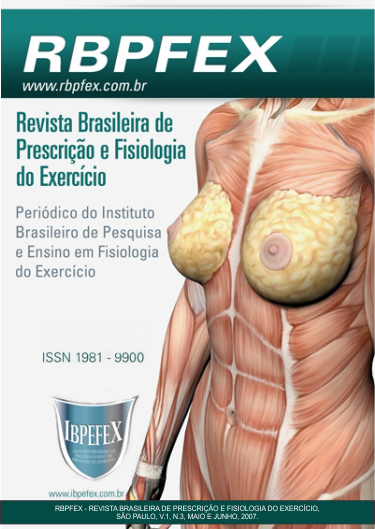Resistence training as therapy for teens with depressive and low self esteem
Abstract
Nowadays teenagers have taken on the social role of adults earlier and earlier. Because of that, they suffer the action of stressful agents and, since they are not able to deal with the pressure, they end up having a low self-esteem, they get depressive. We will deal with the self-esteem and the depression of teenagers, considering the behavior and maturity. In this context, it is suggested that they can benefit from strength training by improving their self-esteem and reducing their level of depression. Moreover, they may improve their self-image. The physiological effects and the metabolic changes observed in strength training improve their self-image, and consequently their self-esteem. Due to this fact they enhance their biopsychosocial quality. It has been observed that some teenagers show aggressive behavior while others suffer from introspectiveness. This way, strength training may help them improve their behavior and, at the same time, reintegrate them into society where values are based on their body image. It also helps them strengthen their feeling of interests, pride, safety, doubt, concern and inferiority according to their own body structure and growth pattern.
References
- Allon, N. Self-perceptions of stigma of overweight in relation to weight-patterns. Am J Clin Nutr. Nº 32. Pag 470 – 480. Princeton. 1979.
- Assis, Simone G; Avanci, Joviana Q; Silva, Cosme M. F. P; Malaquias, Juaci V; Santos, Nilton C; Oliveira, Raquel V.C. A Representação Social do se Adolescente: Um Paso Decisivo na Promoção da Saúde. Escola Nacional de Saúde Pública. Rio de Janeiro. Pag 669 – 680. 2003.
- Bacurau, Reury Frank; Navarro, Francisco; Uchida, Marco Carlos. Hipertrofia Hiperplasia: Fisiologia, Nutrição e Treinamento do Crescimento Muscular. 2ª ed. São Paulo. Phorte editora. Pág 68. 2005.
- Ballone, G.J.; Ortolani, I.V.E.; Pereira Neto, E. Da Emoção à Lesão. Barueri. Editora Malone, 2002.
- Bar-Or, Oded. A Epidemia de Obesidade Juvenil: A Atividade Física é Relevante?. Gatorade Sports Science Institute. Nº 38. Pag 1 – 5. 2003.
- Becker JR, Benno. Manual de Psicologia do Esporte e Exercício. Porto Alegre. Editora Nova Prova, 2000.
- Carrara, Maria Christiane Quillfeldt. A influência da Aarte-Educação na Auto-Estima e Auto-imagem do Adolescente em Atendimento Psicológico. Disertação de Mestrado. Pontifícia Universidade Católica do Rio Grande do Sul. Pag. 33 – 41 Porto Alegre. 2004.
- Coopersmith, S. The antecedents of self-esteem: San Francisco. Freeman pag. 4 –11. 1967.
- Costa, Antônio Carlos G. Protagonismo Juvenil: Adolescência, educação e participação democrática. Fundação Odebrecht. Salvador. 2000.
- Davidoff, Linda L. Introdução à Psicologia. 3ª ed. São Paulo. Editora McKron Books Ltda, 2001.
- Dell’ Angio, Débora Dalbosco; Borges, Jeane Lessinger; Santos, Samara Silvia. Eventos Estressores e Depressão em Adolescentes do Sexo Feminino. PSICO: Revista Semestral da Faculdade de Psicologia da PUCRS. Porto Alegre. Pag. 43 – 50. 2004.
- Erikson, Eric H. Identidade, Juventude e Crise.2ºed. Rio de Janeiro. Editora Guanabara Koogan S. A. 1987.
- Ferreira, Petra Weil. Adolescência, Teoria e Pesquisa, 2ª ed. Porto Alegre. Sulina Editora Ltda, 1984.
- Ferrian, Maria Das Graças C; Dias, Taísa Silva; Silva, Karine Zendonadi Da; Martins, Camilla Soccio. Auto-Imagem Corporal de Adolescentes Atendidos em um Programa Multidisciplinar de Assistência ao Adolescente Obeso. Revista Brasileira de Saúde Materna e Infantil. Recife. Pág. 27 – 33. 2005.
- Fleck, Marcelo Pio De Almeida; Lima, Ana Flávia Barros Da Silva; Louzada, Sérgio; Schestasky, Gustavo; Henriques, Alexandre; Borges, Vivian Roxo; Camely, Suzi. Associação entre sintomas depressivos e funcionamento social em cuidados primários à saúde. Revista saúde pública. Porto Alegre. Pag. 431 – 438. 2202.
- Fleck, Steven J.; Kremer, Willian J. Treinamento de Força para Jovens Atletas. Barueri. Editora Manole, 2001.
- GOBITTA, Mônica E GUZZO, Raquel Souza Lobo. Estudo inicial do inventário de auto-estima (SEI) – Forma A. Psicologia: Reflexões e Críticas. Campinas. pag. 143-150. 2002.
- Mecca, A; Smelser, NJ; Vasconcellos, J. The social Importance of Self-Steem. University of California Press, Berkeley.1989.
- Oehlschlaeger, Maria Helena Klee; Pinheiro, Ricardo Tavares; Horta Bernardo, Gelatti, Cristina E San’tana, Patrícia. Prevalência e fatores associados ao sedentarismo em adolescentes de área urbana. Revista Saúde Pública. Pelotas. Pág. 157 – 163. 2004.
- Rosa, Gedeon; Pereia, Marco Aurélio F; Simâo, Roberto; Perdigâo, Rogério; Silva, Uriá Paixão A. Treinamento de Força em Crianças e Adolescentes. Revista Baiana de Educação Física. Volume 2. Número 3. Salvador. Pag. 35 – 44. 2001.
- Rosenberg, M. Society and the adolescent self-image. Princeton University Press, Princeton. 1989.
- Santarem, José Maria (2001). http://www.fisiculturismo.com.br/ artigo.php?id=45&titulo=Musculação+para+adolescentes.html> Acessado em 28/09/2004.
- Tavares, Kim Samuel. Treinamento com Pesos para Adolescentes com Baixa Auto-Estima. Monografia de Conclusão de Curso. Centro Universitário Metodista IPA. Porto Alegre. 2004.
- Weineck, Jürgen. Treinamento Ideal. 9ª ed. Barueri: Editora Manole, 2003.
- Wilmore, Jack H; Costill, David L. Fisiologia do Esporte e do Exercício2ª ed. São Paulo. Editora Manole. 2001.
Authors who publish in this journal agree to the following terms:
- Authors retain the copyright and grant the journal the right of first publication, with work simultaneously licensed under the Creative Commons Attribution License BY-NC which allows the sharing of the work with acknowledgment of the authorship of the work and initial publication in this journal.
- Authors are authorized to enter into additional contracts separately for non-exclusive distribution of the version of the work published in this journal (eg, publishing in institutional repository or book chapter), with acknowledgment of authorship and initial publication in this journal.
- Authors are allowed and encouraged to post and distribute their work online (eg, in institutional repositories or on their personal page) at any point before or during the editorial process, as this can bring about productive change as well as increase impact and impact. citation of published work (See The Effect of Free Access).






